Field notes: Miami
April 21st, 2021
These field notes are a bit different from previous cities I've explored, because unlike those, Miami is my home! So this post partially serves as a life update—I moved to Miami Beach from California a few months ago, and I'm excited to share my explorations with you.
- What makes Miami special – A few things that stand out to me about Miami.
- Expectation vs reality – Miami is not just the set of Spring Breakers.
- Neighborhoods – A quick lay of the land of the neighborhoods I've explored so far.
- FAQs – Questions I'm often asked.
- My questions – Questions I have about Miami. Let me know if you have answers!
# I. What makes Miami special
- The colors! Everything is more colorful than it needs to be. Everything from high-rises to the clothing people wear to the lifeguard towers are in bright neon and pastels, and the city is overflowing with flowers.
   |  Why paint the building one color when you could paint it ALL the colors?
 |
- Immigrant spirit: This is going to sound cheesy, but it's how I feel so I'm going to say it—Miami embodies America's immigrant spirit more than any other major city I've been to.58% of the city is foreign born, but more than that, when you talk to people in the street or in cafes there's this palpable sense that they made an active choice to be here because they thought it would create opportunities for themselves and their children to lead better lives. In a lot of cases, these are people who risked a lot to make that choice, and they've come here because they believe in American principles and the way we do things (or at least what we strive for).Don't get me wrong, America has a lot of problems, but spending time with the people here who've left Cuba or Venezuela or Haiti or some other part of the world to make the USA their home is a reminder of what makes America special. There's nothing like spending time with immigrants to make you proud of your country.
 |  |
- Oh so flamboyant: Paul Graham talks about how cities whisper different things into your ear, and Miami's whisper is very, very different from SF and NYC (the two cities I'm most familiar with). SF is all about having the longest lever* on an important problem that you can get. NYC whispers lots of different things depending on what circles you're in, but the whisper I personally hear from NYC is that I should be more cool and interesting.Miami seems to whisper to people that you should be entertaining and flamboyant. This takes a lot of different forms. The most visible ones are the party girls walking to the beach with stiletto heels and the macho guys revving the Lamborghinis they rented for the day. The way it's manifested for me personally is that I suddenly have a massive urge to get good at rollerskating so that I can bop around the Miami Beach boardwalk with all of the other people wearing brightly colored skates dancing to bubblegum pop music.* Paul describes this as "power", but I like the lever analogy more because it emphasizes the technological aspects of it. Power is too broad—it can include coercion, and that's frowned upon in SF, but gaining power through smarts and invention is celebrated.
 ↓ She's heading to the beach. Meanwhile I can barely stand up straight in heels, let alone walk in sand with them.
 |  I just want to have this much fun
 |
- Street conversations: Miamians talk to you on the street casually, just like we're all friends hanging out and enjoying life side by side. This is not the norm in SF so it's taken some getting used to, but I love it.In SF, I quickly learned that if a stranger approaches you on the street you should be careful—this is partially because it's not part of the culture for normal people to talk to you on the street, and partially because there is a lot of homelessness and crime and so talking to strangers on the street is a bit unsafe. (My default is to be really chatty with people on the street, and that has bit me in the past in SF. 😞)In Miami by contrast, people strike up conversations with strangers all the time, even just in passing. I've had more street conversations here during a pandemic than I had in SF before Covid happened!
 |  |
- Endlessly entertaining: People here are just plain funny! It feels like Miami just doesn't take itself as seriously as other cities, so people are more fun and laid back. This shows up in all sorts of places, from how people dress to the names of restaurants. It also shows up in the architecture, which I'll get to in the next bullet point.My favorite manifestation is that on the boardwalk, it's extremely common to see people running or biking by with headphones on and belting out a pop song as they zoom by you. They seem to be having an absolute blast, and they're generally very fit too. Hey, if singing Rihanna's Umbrella at the top of your lungs motivates you to exercise more, then I'm all for it!One word for whatever this is is "shamelessness", but that has a bit too much of a negative, moralistic connotation for my liking. Many of the ridiculous activities people do here in Miami aren't quite my style, but I'm extremely happy that they exist around me because they are extremely entertaining and seem to bring joy to the people who partake in them.
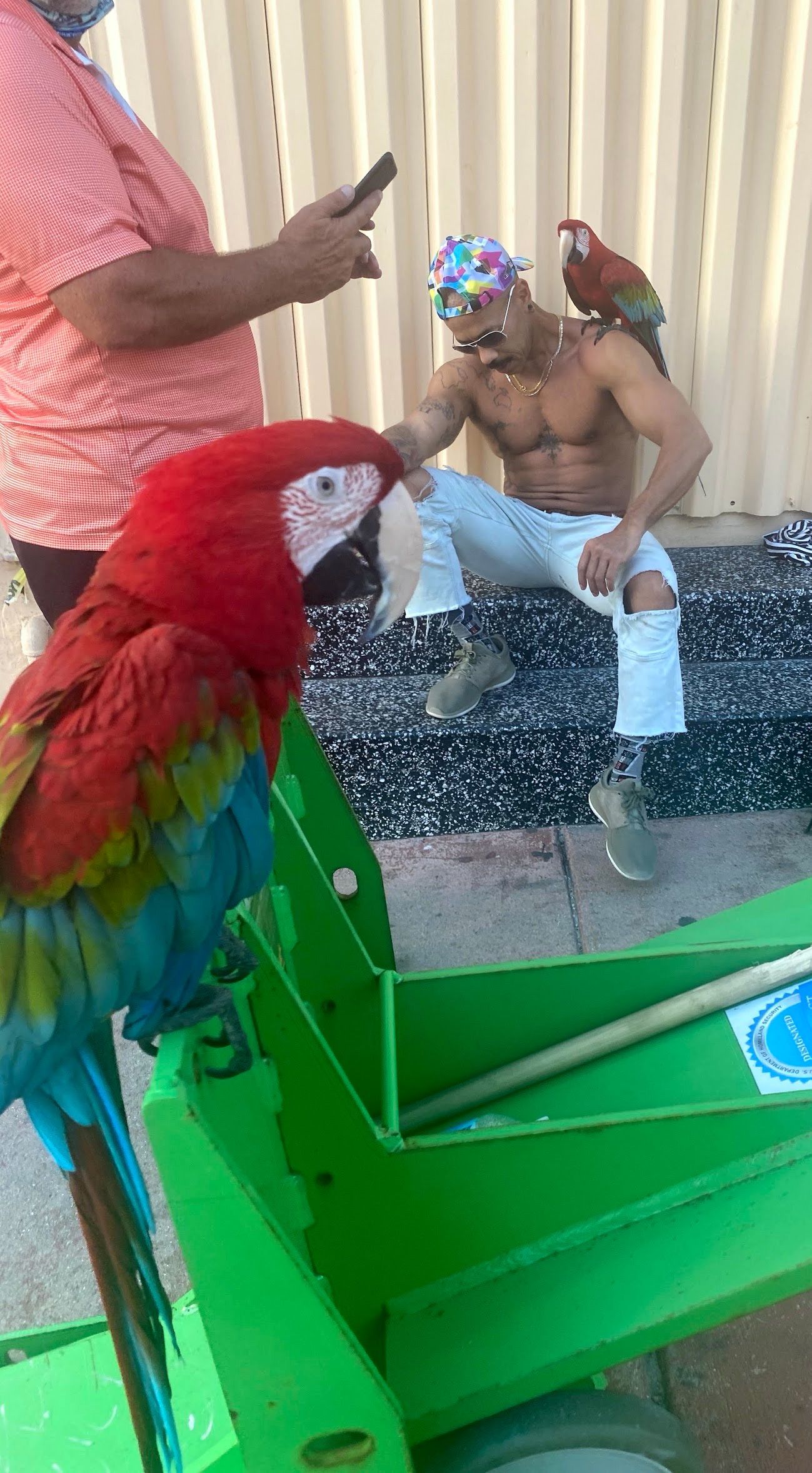 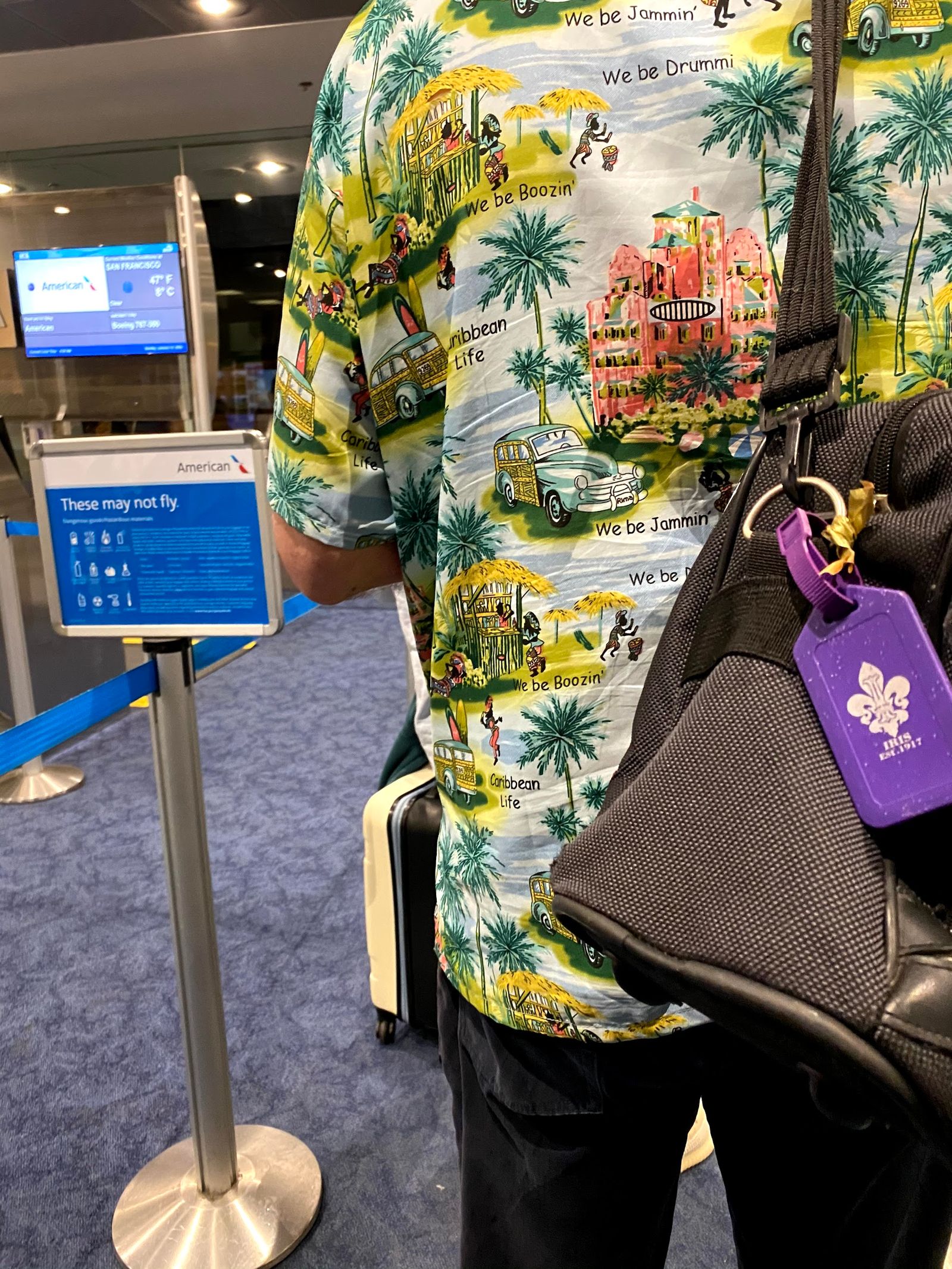 Read his shirt closely. (Photo taken at Miami Airport.) |  Small businessmen have set up shop on the streets of Miami Beach, selling access to their pet parrots (←) and snakes (↑) so that tourists can take pictures with them.
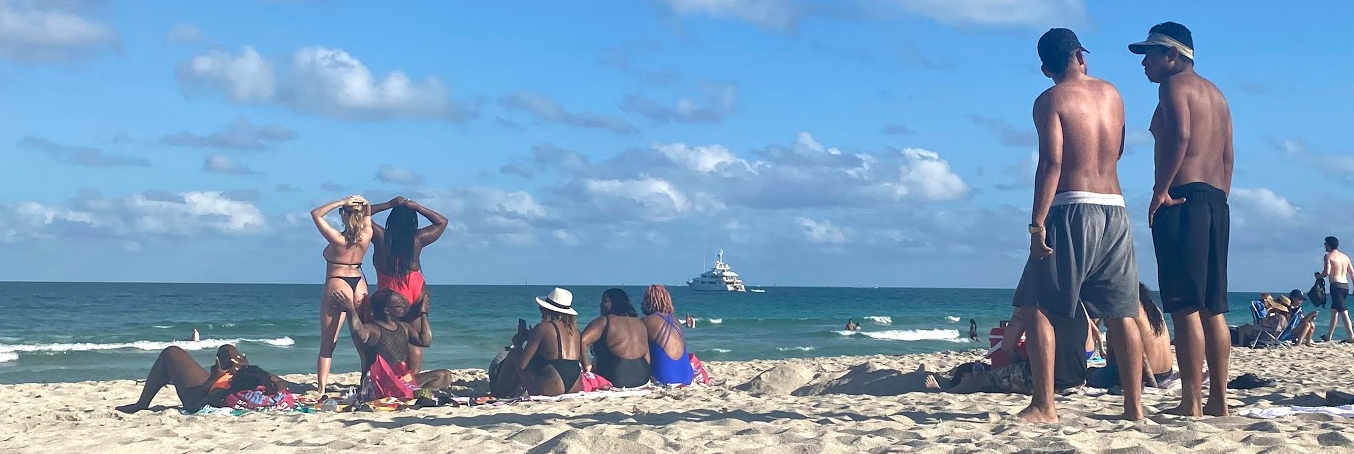 At the beach a few weeks ago, a group of women near me was taking selfies for about 10 minutes straight. Then, one of the excitedly looked at the others and said "Butts? Butts!", and the whole group of girls flipped around and started taking pictures of their butts. It may have been the funniest thing I'd ever seen and I've been quoting it constantly since then.The next time I went to the beach, I saw another group of girls ask a separate group of guys—who I'm pretty sure they didn't know before this—to take pictures of their butts. One of the guys happily obliged. Since the photography was just a 1-man job, his friend then jumped into the picture frame and started grabbing the girls' butts as they shook them for the photo. The girls seemed to be thrilled with this and started posing even more wildly for the camera. Miami is endlessly entertaining. (Photo above)
|
- Laissez faire: It feels like you're actually allowed to do things here. This is best illustrated by Miami's sometimes whacky architecture, but also shows up in things like Covid restrictions being lifted sooner than other major cities. This is related to #5 above, probably in a self-reinforcing loop.It feels like the zoning is less strict here than in SF. In any given neighborhood in central Miami, you get tall buildings, short buildings, medium buildings—building heights are all over the map. Even the historically-protected Art Deco District in Miami Beach has some tall buildings. The buildings you do get are also weirder (which to me is a good thing).This is something I want to learn more about, so please send things my way if you know more about this! Anything about Miami's zoning codes, real estate development sagas, land use economics, and so on is very welcome.
 Hard Rock Hotel (above), James Hotel (below)
 |
The Mammoth Garden at the FAENA hotel is one of the more surreal things I've seen here. I was there for dinner one night, and when trying to leave the hotel I accidentally went through the back doors rather than the front doors. I looked up in the darkness, and there was a shining gold mammoth fossil gleaming down on me. I almost didn't fully register what I was seeing for a few seconds.I vote that when Stewart Brand successfully revives the woolly mammoth, he should host its launch party in the FAENA gardens.  |
- Warm nights: It stays warm after dark, so you can sit outside late into the evening and still have fun. This results in a much more active street life, which is both more fun and makes it feel safer to walk around at night.
 | |
 |  |
- Textures: I've fallen in love with terrazzo (top) and coral stone (bottom) since I've been here. You'll find both textures everywhere in Miami once you start looking for them.
 |  |  |  |
 |  |  |  |
- Hotel hangouts: One perk of living in a vacation town is that you can hang out in gorgeous hotels for just the price of an iced tea. I've been exploring the various terraces, cafes, and pool decks within the high-end hotels along the beach and camping out at them as my office in the afternoons. They generally have great wifi, too!
    |     |
- Culture War armistice: Over the past few years, it's become increasingly difficult to escape a certain type of confrontational, polarized politics which a lot of people call the Culture War. I have major issues with both sides of this "war", and yet I'm often faced with a "you're either with us or against us" framing from both. It's exhausting and intellectually suffocating.Miami is a breath of fresh air. Among the people I've met here, there's a much greater level of civility and tolerance of others' viewpoints. My guess is that the diverse political viewpoints in Florida mean that Floridians have realized that (a) people who have different views aren't always immoral, stupid, or inhuman and (b) they have no choice but to find a way to live with each other, because no single political group is a clear majority in Miami.(Caveat: I've only been here 2.5 months and it's not like I've met a random sampling of the population, so I'm sure this is not the universal experience of Miami. I'm talking only about my experience.)Here's one illustration of what I mean: a friend who's lived in Miami for 3 years recently pointed out that he couldn't tell whether the mayor, Francis Suarez, was a Democrat or a Republican until he looked it up on his Wikipedia page. The Cuban-descended mayor is pro-immigration and pro-LGBTQ, but at the same time he's business-friendly and tough on crime. He doesn't fit cleanly into left-right binary the country has tied itself up into. It turns out that Mayor Francis Suarez is a member of the Republican party, but he's not your typical Republican by any means. (This is a description, not an endorsement.)The fact that Miami elected someone with Suarez's background (and with 86% of the vote!) is meaningful to me—it's impossible to imagine someone like him winning a major political office in San Francisco, because his platform doesn't cleanly fit into a narrow range of acceptable viewpoints. More likely, he'd be deplatformed or booed offstage before he could even get to parts of his platform that would be popular, even though he's really quite centrist when placed on a conventional right-left US political continuum.This isn't just about Mayor Suarez. Since WWII, Miami's mayors have alternated between Democrats and Republicans mostly evenly.I realize that being surrounded by heterogenous political ideas isn't seen as a plus for everyone. I know lots of people who've chosen to move to places specifically because the government and culture match their values as closely as possible (e.g. a Republican moving to a conservative town or a Democrat moving to a blue county). I think that's a totally valid choice, it's just not my personal preference.
- Pro-business: Miami is unabashedly pro-entrepreneur and pro-business. The city government, the culture, and the tax rates are very welcoming of people who want to start and run companies. This is important to me because I believe that businesses are one of the biggest ways to create opportunities and wealth for a community (with some caveats, of course).This business-friendly attitude seems deeply ingrained in Miami's DNA, and I have two guesses as to why:
- 54% of the population is Cuban-descended, and they saw firsthand how Communism ruined their country's economy. They chose to come to America because it celebrates the role that business plays in society.
- Florida has a 0% income tax, and that attracts people who are more likely to value small government, which also correlates with being pro-business (though admittedly it also correlates with other attributes I don't value 😛).
- Plants, plants everywhere! Miami is so lush. Every day I look outside my window at palm trees, birds of paradise, and bright pink blooming flowers, and I just can't get enough of it. The gorgeous tree canopy almost makes Miami's infamous heat a lot easier to bear than you might expect. Personally, I'd prefer to walk in tropical Miami under giant banyan trees in 95℉ weather than in dry Los Angeles under the direct sun.
    |    |
# II. Expectation vs reality
One of my goals with these field notes is to break down misconceptions about Miami that I myself had before coming here. I'd thought that Miami was a soulless sea of glass buildings with penthouses filled with people snorting cocaine. I'd been warned that it was an extremely car-centric city with little street life, and that the humidity was so suffocating that you could barely walk from your front door to your car without breathing a sigh of relief as soon as your air conditioning began to wash over you.
These stereotypes aren't false—I'm confident you can find cocaine if you're looking for it, and that the August weather will indeed be suffocating—but they capture just a tiny sliver of what Miami is about. My experience of this city has been completely different.
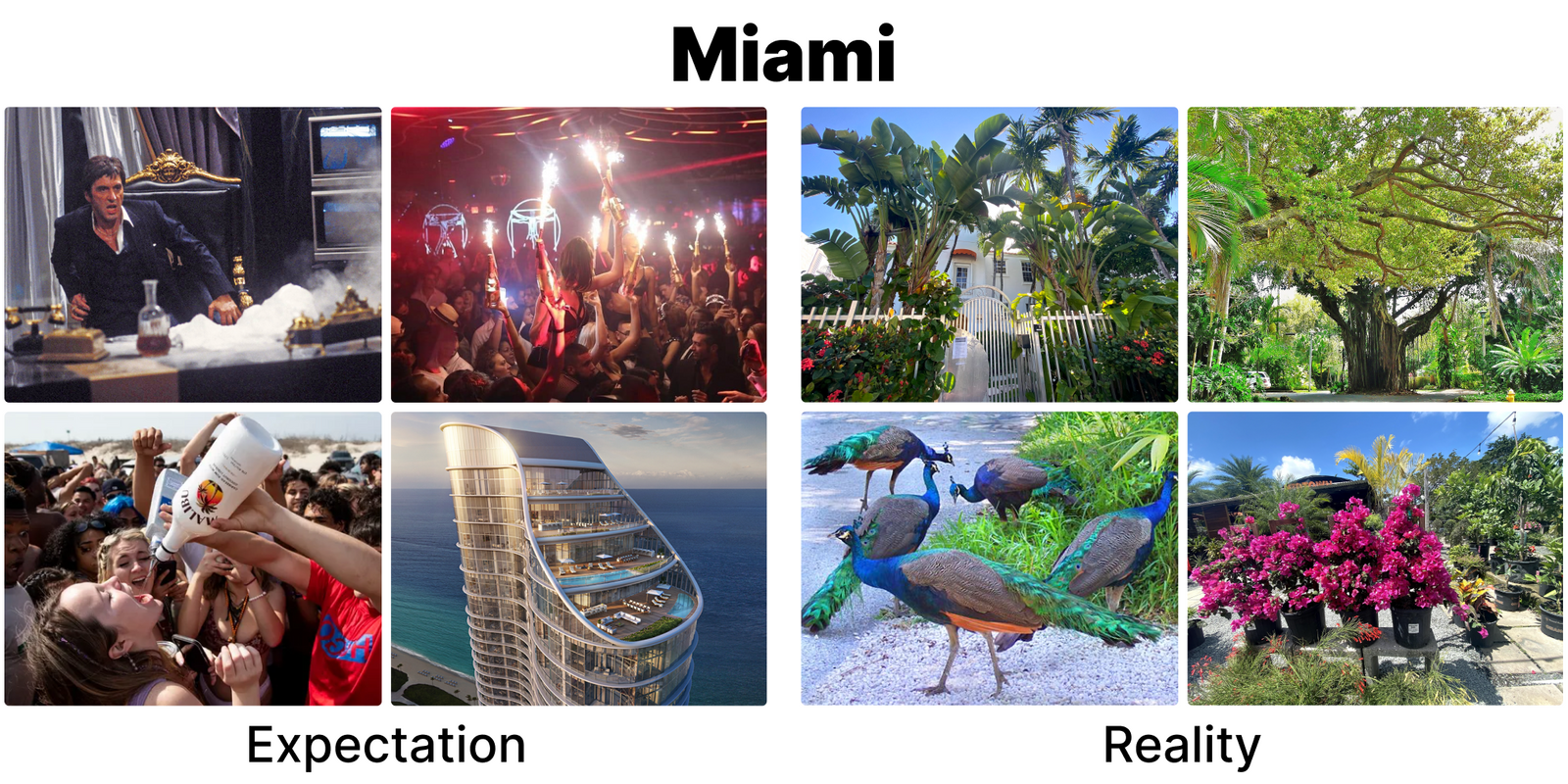
Here's my slice of Miami:
- I wake up every morning with birds chirping and sunshine streaming through my window, filtered by palm trees and a massive bird of paradise just outside my window.
- I live in a charming 4-unit building with a cute shared courtyard, and my unit has a front yard all to its own. There's almost no street noise, so I can hear the parrots chirping as I make my morning coffee.
- I'm in walking distance to a gorgeous outdoor pool, a Whole Foods, the beach, dozens of cafes and restaurants, and the boardwalk.
- When I want to go into downtown, I take a bus that runs so often that I don't even know how long the interval is, because all I need to know is it'll show up frequently enough that I don't have to think about it.
In short, my life is filled with sunshine, walking, quiet, and easy access to transit. The stereotypes I had of Miami certainly exist, but they are not overpowering by any means.
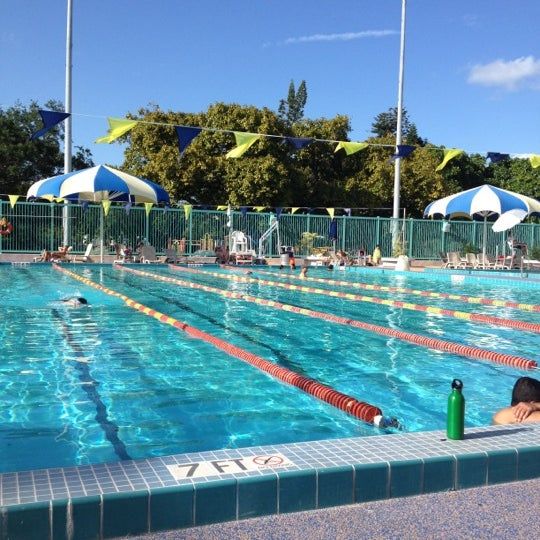 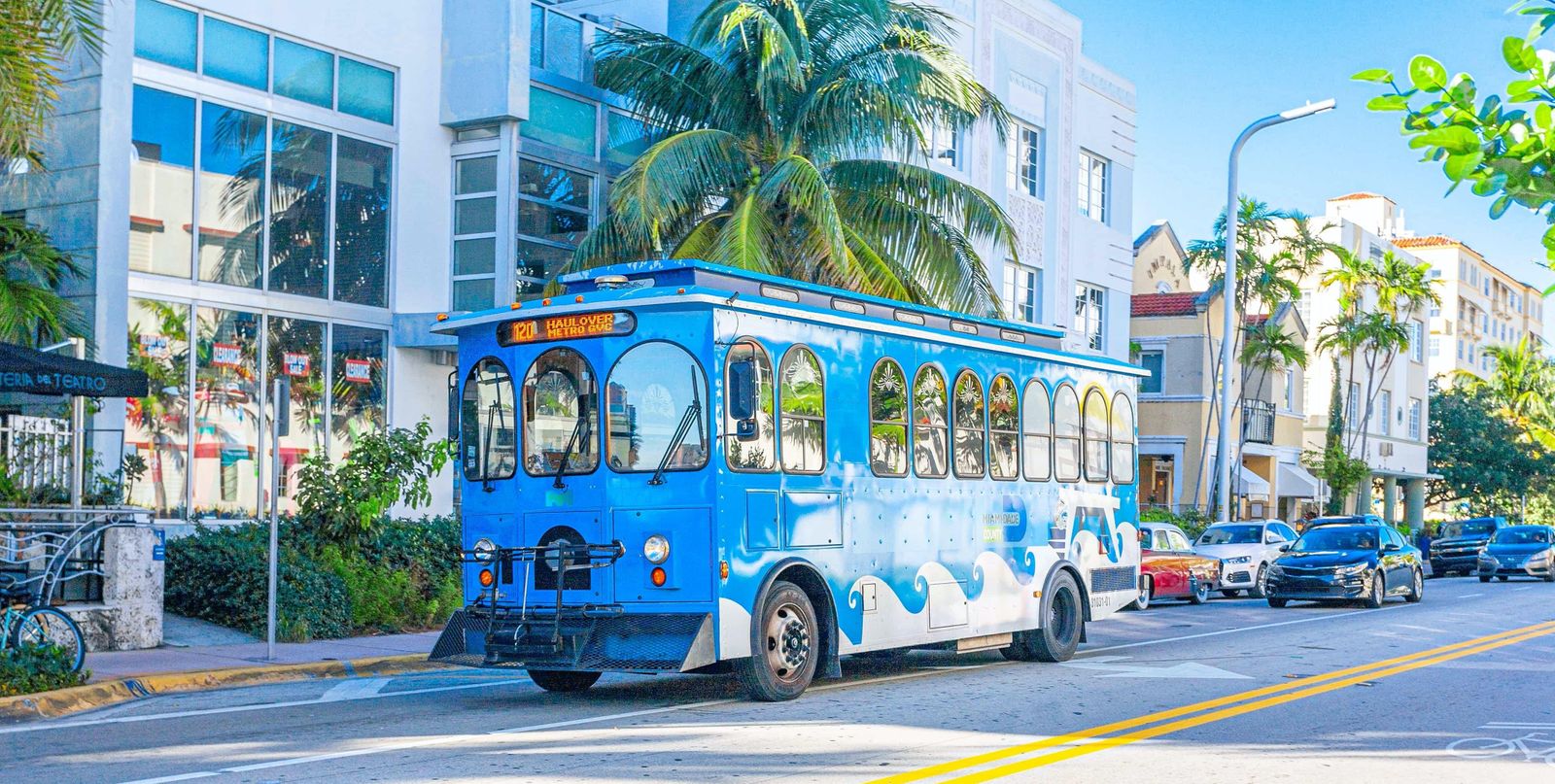 |  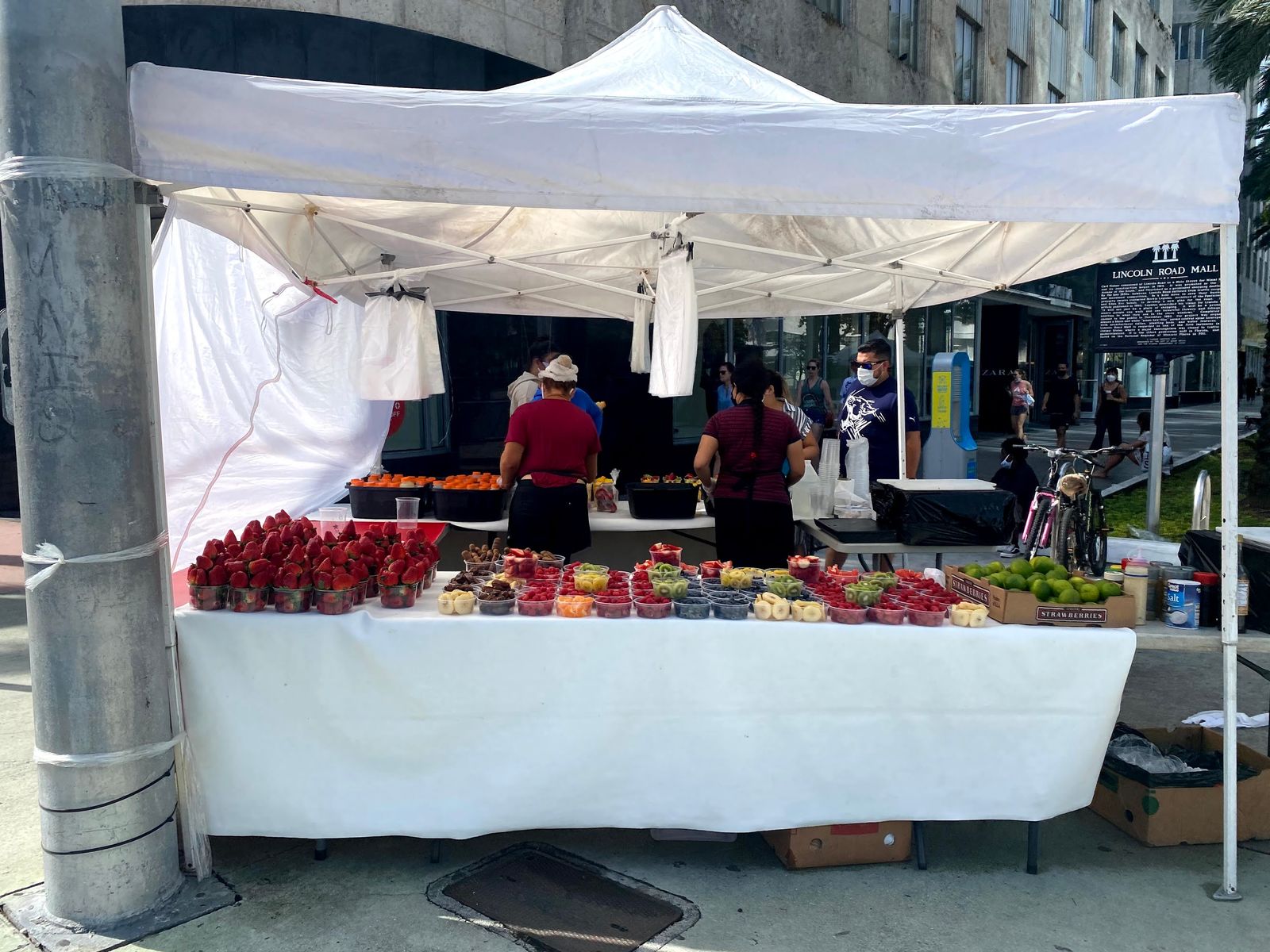 |
So it might be surprising to learn that this cute little existence is right in the heart of Miami Beach. Yes, that Miami Beach. If you didn't see the recent news, Miami Beach recently rejuvenated its reputation as Spring Break capital of the world by instating an emergency curfew in response to out of control parties. (Yes, during a pandemic... 🤦♀️)
This doesn't exactly square up with my peaceful, almost village-like lifestyle that I described above. The key thing is that this Spring Break sliver of Miami Beach is entirely avoidable. Ocean Drive is where most of the debauchery in Miami Beach occurs, and if you stay way from that strip then you'll be able to avoid it entirely.
Many people associate Miami Beach with Spring Break and other drunken degeneracy because (a) they've never actually been or (b) when they visited, they primarily hung out along Ocean Drive, which is the capital of Spring Break. I personally only experience the Ocean Drive party scene when I feel in the mood for some people watching (my favorite kind of entertainment), but otherwise it doesn't intersect with my daily life much at all. It's not nearly as all-encompassing of life in Miami Beach as people assume.

# III. Neighborhoods
Miami has lots of other kinds of neighborhoods as well, and the Spring Break stereotypes of Miami are even less of a match to those than to my slice of Miami Beach. Here's a sampler of the neighborhoods I've explored so far:
- Brickell & Edgewater: For those gleaming towers with fancy amenities, you can live in Brickell or Edgewater. Most of Miami's real estate development in the past few decades has happened in these neighborhoods rather than downtown Miami, and I've been told that this is because there are a few families who own large swathes of downtown and they weren't interested in developing it. I'm interested to verify this information and to learn more about it, if anyone knows more about it!
 |  |
- Coconut Grove & Coral Gables: For a more suburban existence, you can go to leafy Coconut Grove or Coral Gables. To me, these neighborhoods feel a little bit like a tropical version of Palo Alto, CA (in a good way).
 Whenever I visit Coconut Grove, my friends get annoyed with me because I use the word "lush" so often.
 |  Miami's city hall is a former seaplane terminal for Pan American, and it sits on the Coconut Grove Marina.
  |
- Little Havana & Hialeah: For fun street conversations and a fantastic selection of Cuban and Central American cuisine, you can go to Little Havana or Hialeah. Little Havana was the center of the Cuban community in Miami for a long time, but it's now shifted towards Hialeah, while Little Havana now has more immigrants from Central America. Hialeah has the highest percentage of Cuban and Cuban American residents of any city in the United States, at 73.37% of the population.
   |  ↑ Mexican restaurant in Little Havana with a sense of humor. ↓
 |
- Wynwood: For an artsy neighborhood filled with color and street art, you can go to Wynwood. It has lots of hip shops, and the whole place feels like it was made to be photographed on Instagram.
  |   |
- Little Haiti: For everything Haitian, you can go to Little Haiti. While Little Havana is really a mix of lots of Caribbean, Central American, and South American communities, Little Haiti has a larger majority of Haitians.Walking around Little Haiti I definitely got some confused looks that seemed to say "What are you doing here?" People were very friendly and welcoming, but they just seemed confused by my presence. I got a strong sense that non-Haitians aren't typical customers at Haitian businesses in that part of town.For example we went to a restaurant around 11am, and my friend (who admires Haitian culture a lot and has spent a fair bit of time there) asked them what they had on the menu. The woman said "It's soup time. We only have soup," but then asked, "But are you sure you want this?" with the implication that it might be too exotic for our palettes or something. He said "Yes I'm sure" and ordered 3 bowls, 1 for each of us. But then she only brought out 1 and said, "Try it first to make sure you like it". As we tried a sip, she had the most worried look on her face.But she had nothing to worry about! The soup was tasty! And really it wasn't strange at all, in fact it tasted very familiar, like chicken soup almost. When we confirmed that we liked it and ordered more, she chuckled but also seemed like she wasn't quite sure she believed that we actually liked it.
  |   |
- Key Biscayne: If you want to feel like you live in a golf resort and a beach resort at the same time while also having downtown Miami just 15 minutes away, Key Biscayne is the place to go.Key Biscayne is a beautiful island off the coast of Miami. In the center, it has really nice suburban houses, and there are two massive parks on either end of the island.My favorite detail about Key Biscayne is that electric golf carts are one of the primary ways of getting around the island. With 1 golf cart for every 13 residents, they dominate the streets. The speed limit in Key Biscayne is 20mph, and car drivers have seemed to accept that they are guests in the golf carts' kingdom.
 | |
 |  |
 |
I've only been in Miami a few months so I'm no means an expert, but I've been loving the variety and color I've discovered as I've been exploring the city. If you have recommendations for other places to explore, let me know!
Here's the neighborhood map of Miami:
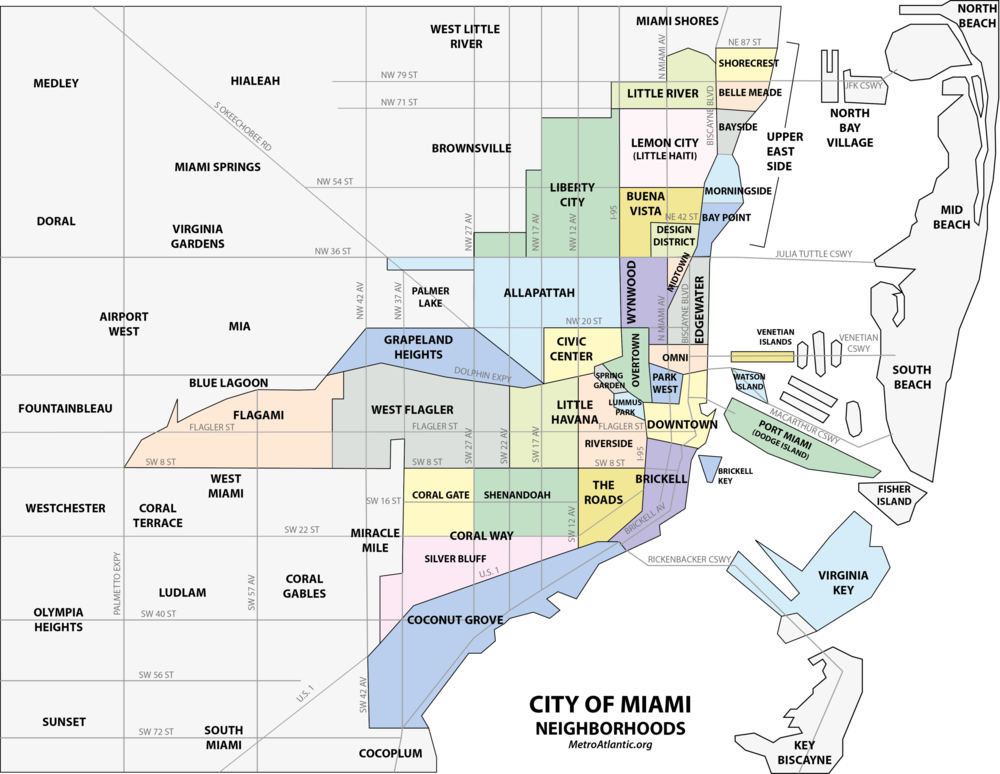
Q: How is Miami's infrastructure and transit? Is it super car-centric?
I’m based in Miami Beach, an island off the coast which is quite different from Miami mainland. Miami Beach is super walkable. I don’t have a car, and I have a Whole Foods, beautiful public pool, lots of cafes, and so on within 8 minutes walking from my place. There's also a boardwalk running trail nearby which is also gorgeous, and there's a pedestrian-friendly street called Española Way with lots of restaurants.
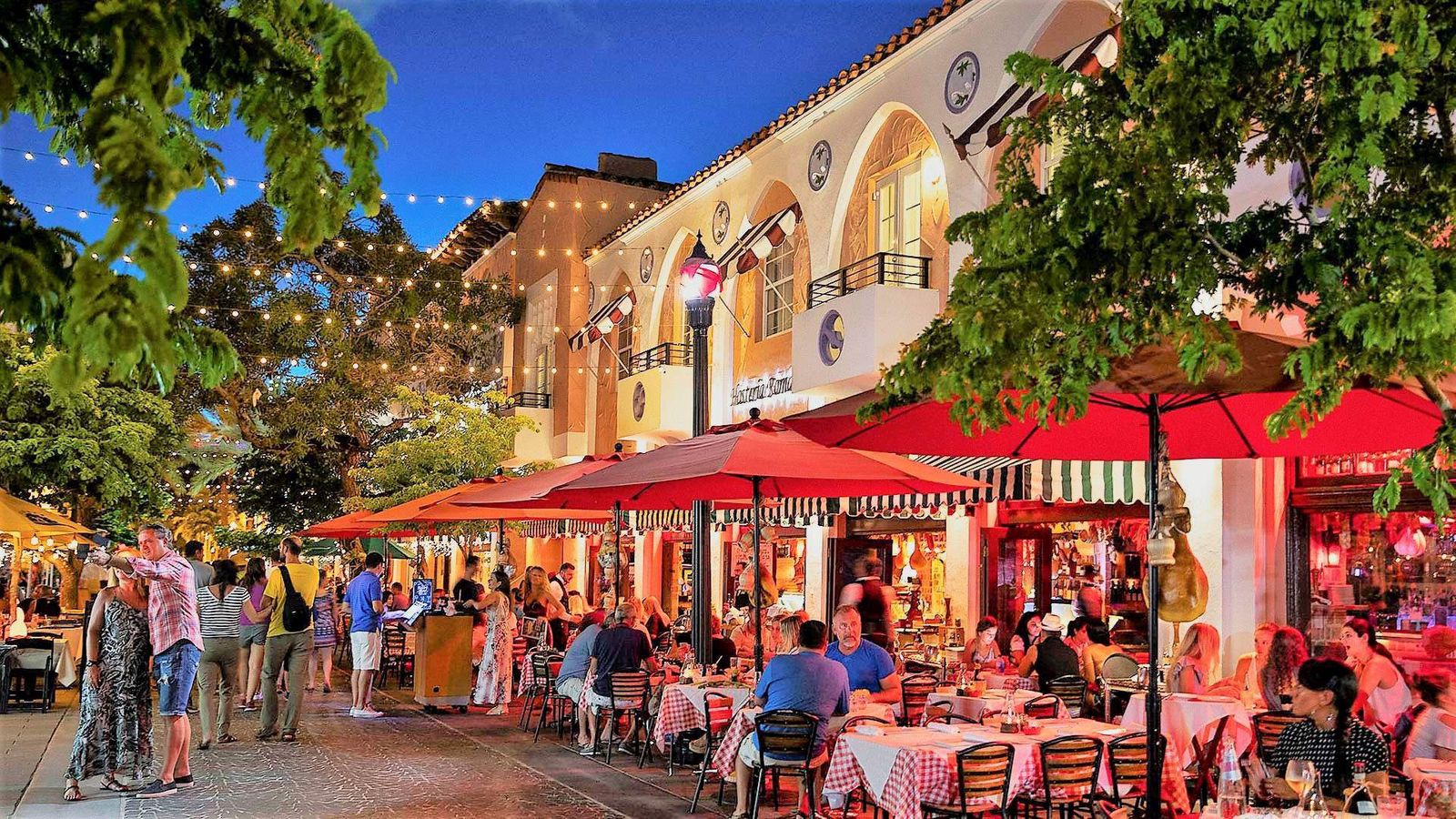
Miami mainland is more varied depending where you are. The Brickell neighborhood is a bit like Midtown Manhattan; super dense, but in my opinion not that pleasant to walk. The Design District and Wynwood are a bit like the Mission in SF; walkable but a bit spread out.
Most of the rest of the city is very car-centered I think though. I haven’t explored the other parts so much so I can’t speak to that as much.
TLDR there are definitely some very walkable parts of Miami, though I think the median experience of the city if you just picked at totally random spot on the map would be very car-dependent.
Q: How bad was it to live in Miami Beach during Spring Break?
To be honest, I didn't really notice it until my mom texted me "Are you okay?!?!" and shared a CNN article about how Miami Beach had declared a state of emergency due to the Spring Breakers. I'm sure if I had gone for a late-night walk along Ocean Drive I would've noticed more of what was going on, but where I live in the middle of the island (which is a few blocks away from Ocean Drive) I noticed almost nothing. The only part that really impacted me was the 8pm curfew they put in place going in and out of Miami Beach, because I decided not to go to dinner with a friend on the mainland for fear of not being able to get back home, which was certainly inconvenient but not the end of the world.
Q: What should I read/watch to get a taste of Miami without actually going there?
I'm only going to give one answer rather than inundating you in recommendations, in hopes that you actually watch it: Burn Notice.
Burn Notice about a CIA agent whose identity was compromised so he gets stuck in Miami. He goes about the city helping little old ladies and other nice people solve impossible missions.
My favorite part is that the main character narrates throughout the show, so you learn how to tail people without being noticed and build makeshift listening devices and that sort of thing. It's also a great way to explore Miami vicariously, because they shot the show in lots of different locations throughout the city.
Q: Mosquitos/bugs?
I haven't noticed many bugs here in Miami Beach at all, which is super surprising since it's a tropical environment. The Miami area in general apparently has a lot of mosquitoes (though I haven't experienced them firsthand), but Miami Beach itself sprays larvicide on the streets so there aren't many mosquitoes here. I've gotten few bug and mosquito bites in the months I've gotten here, but it's not a constant nuisance.
Q: Weather?
I can't really answer this yet, because I've only been here during the winter and spring. During that time, the weather has been gorgeous and not too hot. The summer and fall will be less comfortable, especially during hurricane season (June 1 - Nov 30), but I can't speak to that from firsthand experience just yet.
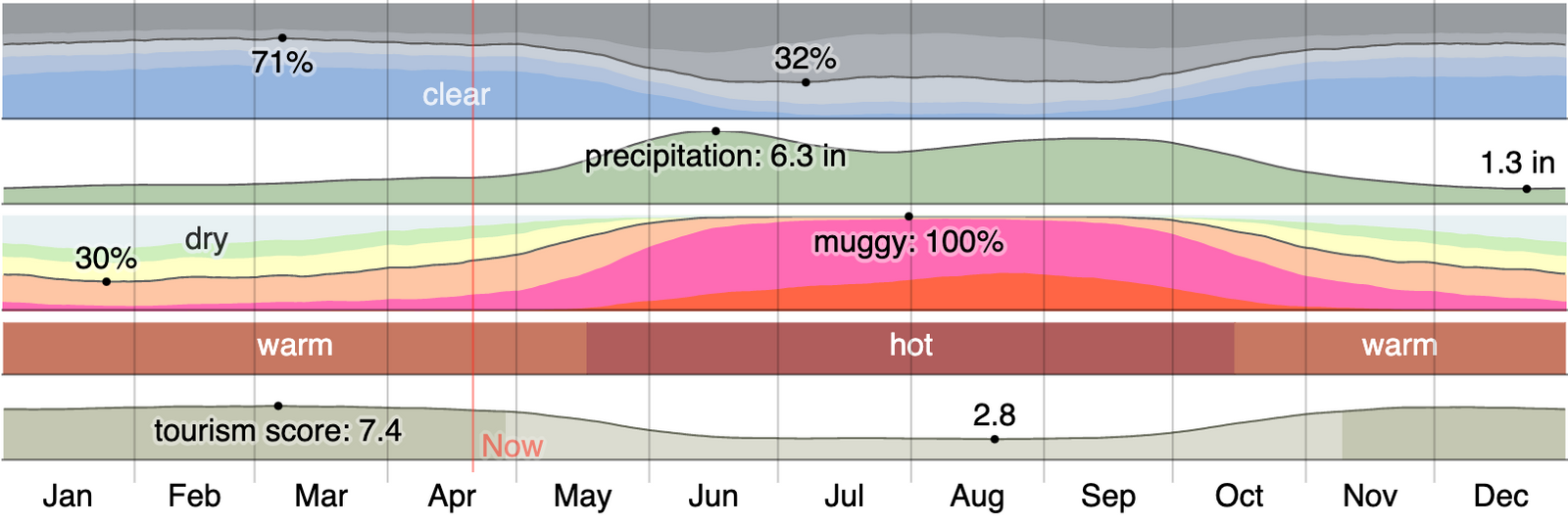
Source: Weather Spark
Q: Miscellaneous facts, observations, and pointers I've picked up along that way:
- Here's a nice map of cycling routes in Miami.
- People text and drive in Miami more than any other place I've seen. I don't have stats on this, but it's hard to miss when you're walking around because people roll through stop signs while reading their phones constantly. It's honestly terrifying but also impressive how pervasive it is. The best was an Uber driver I had who was watching a rave on his phone while driving. (Photo to the right; sorry it's so blurry.)

- Demographics of Miami City and Miami-Dade County:
- Miami City's population is 58% foreign born, 72% Hispanic, and 54% Cuban.
- In the 2010 census, the largest ancestry groups in Miami-Dade County were:
- 34.3% Cuban
- 4.6% Colombian
- 4.5% Haitian
- 4.2% Nicaraguan
- 3.7% Puerto Rican
- 3.4% American
- 2.3% Dominican
- 2.3% German
- 2.2% Italian
- 2.2% Honduran
- 2.1% Mexican
- 1.9% Venezuelan
- 1.8% Irish
- 1.6% Peruvian
- 1.5% English
- 1.4% Jamaican
- 1.1% Argentine
- 1.0% Russian
- Miami Beach is famous for its street cats who roam the island. I don't think it's possible to spend more than a few hours exploring Miami Beach without crossing paths with at least one of them.
- Miami Beach also has adorable wild parakeets that migrate to Miami in early spring and tend to disappear around November.
 |  |
- What's the story behind BrightLine, Florida's privately-run high speed passenger rail?
- How do places like Miami Beach and Hialeah coordinate with Miami? My understanding is that they are separate entities from Miami City, but they feel like a fairly cohesive unit to me.
- What are the de jure and de facto structures of government for Miami? Where does the power for various decision reside?
- The reported crime rates in Miami Beach are similar or worse to SF, but it feels much, much safer here and no one has bars on their windows. It just doesn't add up to me. What's going on?
 My best guesses are that (a) a lot of crimes occur in nightclubs but not in the neighborhood area where I live and (b) crimes may be under-reported in SF because it's widely believed that enforcement is lax.
My best guesses are that (a) a lot of crimes occur in nightclubs but not in the neighborhood area where I live and (b) crimes may be under-reported in SF because it's widely believed that enforcement is lax. - Miami has a lot of practice in disaster response because of the hurricanes that ravage the coast every few years. I've only heard positive things from the locals about how the municipality helps prepare for hurricanes. Did that expertise transfer over to the early COVID response?
- Why does Meridian Avenue in South Beach between 1st and 14th have so many more trees than any other continuous street? It's glorious.
 | |
 |  |
That's all for today. I'll continue sharing photos, facts, and discoveries in this Twitter thread. If you find yourself in Miami, let me know!
Keep in touch!

